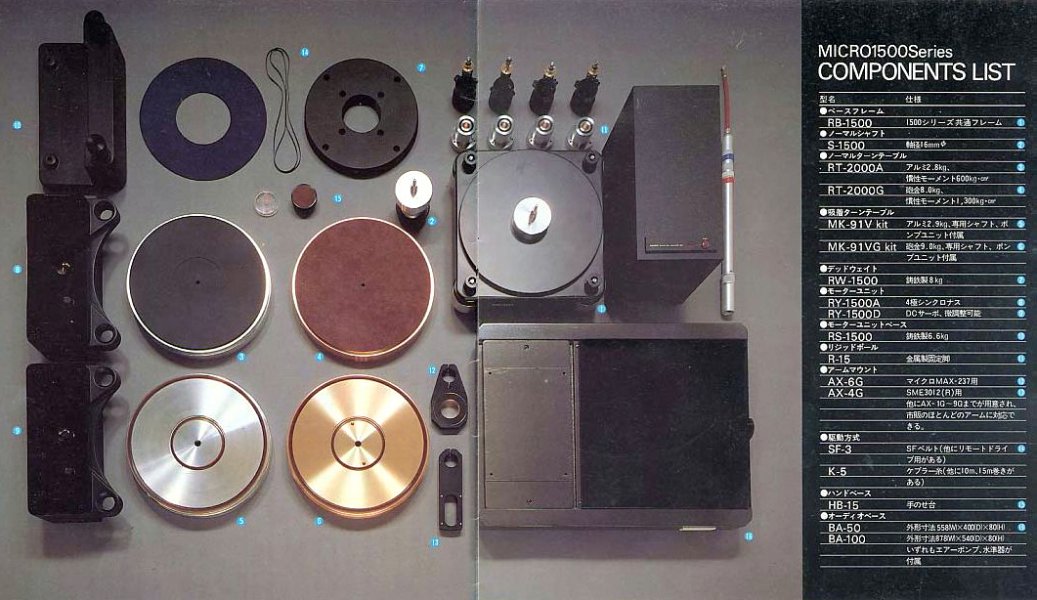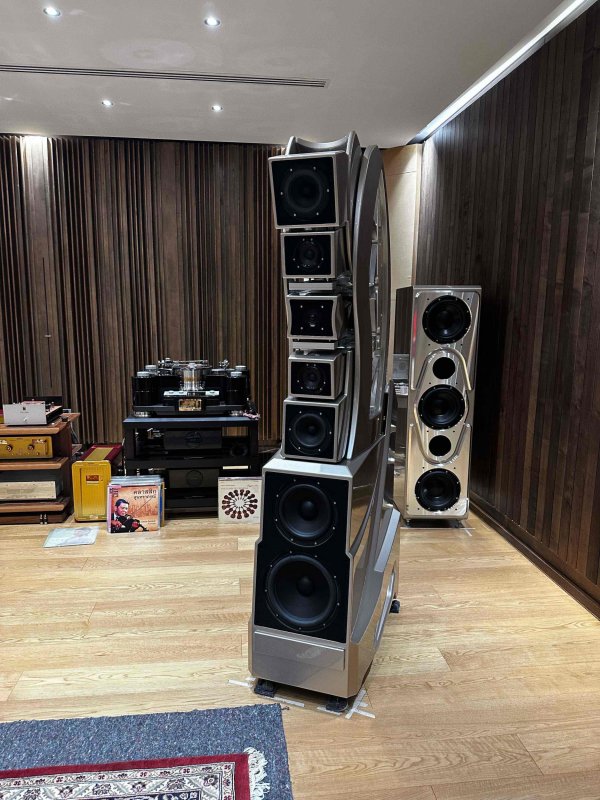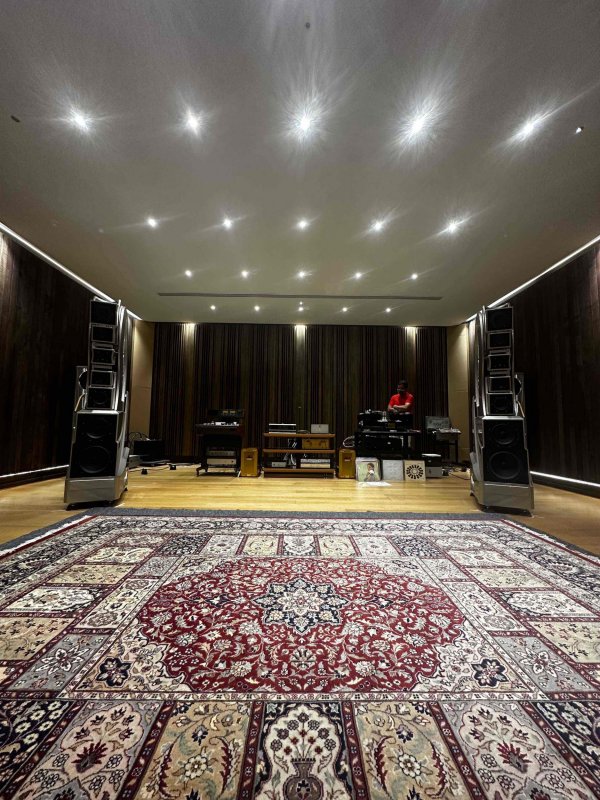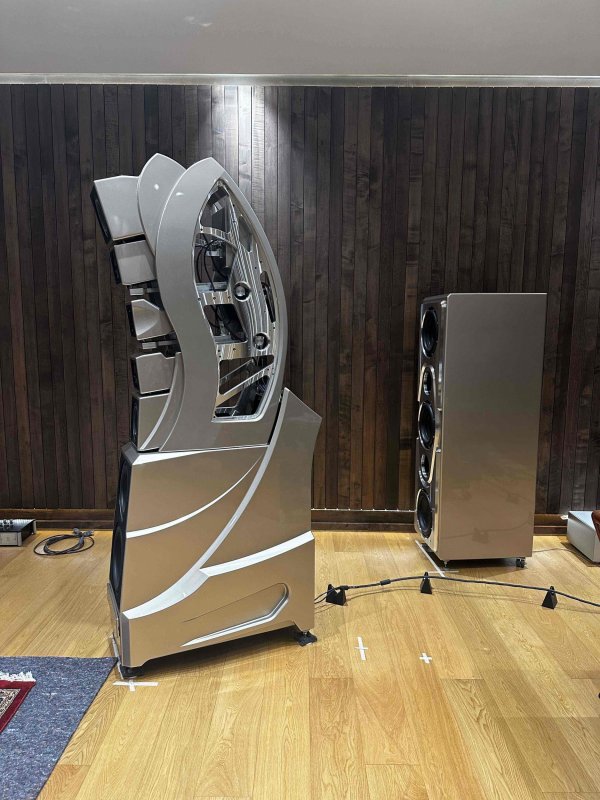This story began on an autumn day in 2017, 6 years ago in Cologne Frechen. More precisely, in the realms of @shakti
At that time, there were all the big Micro Seiki turntables from the RX-1500 to the big RX-8000 to marvel at:
 www.whatsbestforum.com
www.whatsbestforum.com
In German, his Micro Seiki comparison thread:
https://www.analog-forum.de/wbboard/index.php?thread/133582-shakti-vergleich-micro-seiki-laufwerke/
At the age of 16, I myself had never heard of Micro turntables before. When I saw this RX-1500, however, I was shockingly enamoured:

My enthusiasm for this drive, as well as for the different versions, was ignited.
The concept of the RX-1500 is based on the pen of the chief developer Hideaki Nishikawa and is a development from the late 70s, which was brought to market maturity in the early 80s.
The following versions were offered in Germany:
- Micro Seiki RX-1500D (basic version with aluminium plate flanged motor)
- Micro Seiki RX-1500D + RS-1500 (basic version with aluminium plate and external motor base)
- Micro Seiki RX-1500 VG (aluminium plate, with external motor base, air bearing and plate suction)
- Micro Seiki RX-1500G (basic version with brass disc and external motor base)
- Micro Seiki RX-1500 VFG (brass disc, with external motor base, air bearing and plate suction)

I soon realised that there was also a large but nowadays rare range of accessories for this drive. Beautifully illustrated in this picture:

So I started my search for an RX-1500, primarily looking for a "D" model.
Unfortunately, 1500s are quite rare, but after two years of searching I found my first micro with SME 3009:

This turntable allowed me to gain my first experience in the field of adjusting, setting up and tuning the sound of record players. I became intensively involved with analogue playback via vinyl.
Over time, I had the opportunity to make a further upgrade, but now with an external motorised stand and the RS-10 record weight. I was also able to try out sound impressions from aluminium vs. brass bases on the Micro Seiki for the first time:

Over time, I tried a wide variety of tonearms and cartridges on my micro. For example, I had an extremely rare Fidelity Research FR-66fx:

But I have also been able to compare the sound of other tonearms such as the Schick 9.6, Fidelity Research FR-64fx, Fidelity Research FR-54, SME 3009R and SME 3012R on my micro.
That's why I've been able to familiarise myself intensively with the different concepts of the developers of Ikeda san and co:

The wide range of experiences and the exploration of the most diverse combinations led to increasing professionalisation. Ernst Acoustics was born. In short, this was a development that took years.
But that's not the point. I would rather emphasise the profound importance of the Micro Seiki RX-1500 for my personal development. All my experiences with analogue playback and my enthusiasm for analogue are based on this model.
In this day and age:
Today's record players from TechDas, a company founded by Nishikawa a few years ago as the "successor" to Micro Seiki, are based on this original concept of the RX-1500 and bring the developments of that time into the 21st century. Due to my deep familiarity with Micro Seiki, a good friend asked me to install a TechDas AirForve V at his place:

I also regularly look after a customer with a TechDas Airforce 3, which is based on the basic idea of the Micro Seiki RX-1500 VG.
Most recently, I had the great and rare experience of listening to a TechDas Airforce Zero with the serial number 1 in Bangkok. This drive represents the pinnacle of Nishikawa's developments and is a sonic experience.
Nevertheless, the basic sonic DNA of a micro was quite perceptible:



As you can read, I have a great attachment to these machines that are used purely for playing records.
So it was all the sadder to read recently that Nishikawa has passed away. I deeply honour this gentleman for his record players, which never cease to inspire me.
Yesterday I had the opportunity to acquire another very rare machine from the pen of Nishikawa and to make the next major upgrade. But more on that in the near future.
I'm now getting ready to set it up so that I can enjoy it with an alcoholic drink in a few hours.
More in the days to come...
Audiophile greetings,
Florian
At that time, there were all the big Micro Seiki turntables from the RX-1500 to the big RX-8000 to marvel at:
Shakti's System: Micro Seiki 8000, Koetsu, VDH, Airtight, Zingali, YG Anat,
http://zero-distortion.org/micro_seiki_8000_mkii_koetsu_colibri_thoress_airtight/ This will highlight the first exposure to Micro Seiki 8000 mkII with Ikeda 407 (with VTA lifter) with VDH Stradivarius and FR 64s with the Koetsus. The VDH has a body with Hawaiian Koa Wood and an old...
In German, his Micro Seiki comparison thread:
https://www.analog-forum.de/wbboard/index.php?thread/133582-shakti-vergleich-micro-seiki-laufwerke/
At the age of 16, I myself had never heard of Micro turntables before. When I saw this RX-1500, however, I was shockingly enamoured:
My enthusiasm for this drive, as well as for the different versions, was ignited.
The concept of the RX-1500 is based on the pen of the chief developer Hideaki Nishikawa and is a development from the late 70s, which was brought to market maturity in the early 80s.
The following versions were offered in Germany:
- Micro Seiki RX-1500D (basic version with aluminium plate flanged motor)
- Micro Seiki RX-1500D + RS-1500 (basic version with aluminium plate and external motor base)
- Micro Seiki RX-1500 VG (aluminium plate, with external motor base, air bearing and plate suction)
- Micro Seiki RX-1500G (basic version with brass disc and external motor base)
- Micro Seiki RX-1500 VFG (brass disc, with external motor base, air bearing and plate suction)

I soon realised that there was also a large but nowadays rare range of accessories for this drive. Beautifully illustrated in this picture:
So I started my search for an RX-1500, primarily looking for a "D" model.
Unfortunately, 1500s are quite rare, but after two years of searching I found my first micro with SME 3009:
This turntable allowed me to gain my first experience in the field of adjusting, setting up and tuning the sound of record players. I became intensively involved with analogue playback via vinyl.
Over time, I had the opportunity to make a further upgrade, but now with an external motorised stand and the RS-10 record weight. I was also able to try out sound impressions from aluminium vs. brass bases on the Micro Seiki for the first time:
Over time, I tried a wide variety of tonearms and cartridges on my micro. For example, I had an extremely rare Fidelity Research FR-66fx:
But I have also been able to compare the sound of other tonearms such as the Schick 9.6, Fidelity Research FR-64fx, Fidelity Research FR-54, SME 3009R and SME 3012R on my micro.
That's why I've been able to familiarise myself intensively with the different concepts of the developers of Ikeda san and co:
The wide range of experiences and the exploration of the most diverse combinations led to increasing professionalisation. Ernst Acoustics was born. In short, this was a development that took years.
But that's not the point. I would rather emphasise the profound importance of the Micro Seiki RX-1500 for my personal development. All my experiences with analogue playback and my enthusiasm for analogue are based on this model.
In this day and age:
Today's record players from TechDas, a company founded by Nishikawa a few years ago as the "successor" to Micro Seiki, are based on this original concept of the RX-1500 and bring the developments of that time into the 21st century. Due to my deep familiarity with Micro Seiki, a good friend asked me to install a TechDas AirForve V at his place:
I also regularly look after a customer with a TechDas Airforce 3, which is based on the basic idea of the Micro Seiki RX-1500 VG.
Most recently, I had the great and rare experience of listening to a TechDas Airforce Zero with the serial number 1 in Bangkok. This drive represents the pinnacle of Nishikawa's developments and is a sonic experience.
Nevertheless, the basic sonic DNA of a micro was quite perceptible:


As you can read, I have a great attachment to these machines that are used purely for playing records.
So it was all the sadder to read recently that Nishikawa has passed away. I deeply honour this gentleman for his record players, which never cease to inspire me.
Yesterday I had the opportunity to acquire another very rare machine from the pen of Nishikawa and to make the next major upgrade. But more on that in the near future.
I'm now getting ready to set it up so that I can enjoy it with an alcoholic drink in a few hours.
More in the days to come...
Audiophile greetings,
Florian


